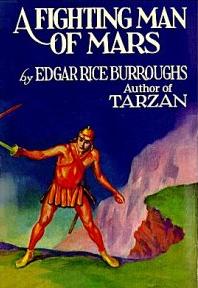
A Fighting Man of Mars is a science fantasy novel by American writer Edgar Rice Burroughs, the seventh of his Barsoom series. Burroughs began writing it on February 28, 1929, and the finished story was first published in The Blue Book Magazine as a six-part serial in the issues for April to September 1930. It was later published as a complete novel by Metropolitan in May 1931.

The Worm Ouroboros is a heroic high fantasy novel by English writer E. R. Eddison, first published in 1922. The book describes the protracted war between the domineering King Gorice of Witchland and the Lords of Demonland in an imaginary world that appears mainly medieval and partly reminiscent of Norse sagas. The work is slightly related to Eddison's later Zimiamvian Trilogy, and collectively they are sometimes referred to as the Zimiamvian series.

Lilith: A Romance is a fantasy novel by Scottish writer George MacDonald, first published in 1895. It was reprinted in paperback by Ballantine Books as the fifth volume of the Ballantine Adult Fantasy series in September 1969.

Phantastes: A Faerie Romance for Men and Women is a fantasy novel by Scottish writer George MacDonald published in London in 1858.
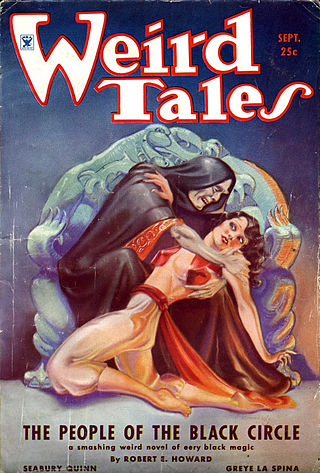
"The People of the Black Circle" is one of the original novellas about Conan the Cimmerian, written by American author Robert E. Howard and first published in Weird Tales magazine in three parts over the September, October and November 1934 issues. Howard earned $250 for the publication of this story.
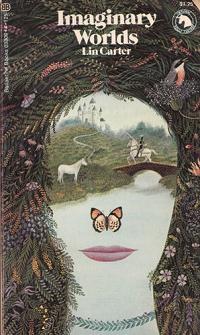
The Ballantine Adult Fantasy series was an imprint of American publisher Ballantine Books. Launched in 1969, the series reissued a number of works of fantasy literature which were out of print or dispersed in back issues of pulp magazines, in cheap paperback form—including works by authors such as James Branch Cabell, Lord Dunsany, Ernest Bramah, Hope Mirrlees, and William Morris. The series lasted until 1974.

Auriol: or, The Elixir of Life is a historical and gothic novel by British novelist William Harrison Ainsworth. It was first published in 1844 in serial form, under the title Revelations of London.

The World's Desire is a fantasy novel first published in 1890 and written by H. Rider Haggard and Andrew Lang. It was published in paperback by Ballantine Books as the fortieth volume of the Ballantine Adult Fantasy series in January 1972.
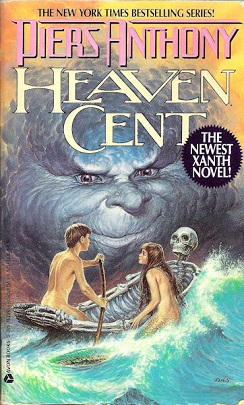
Heaven Cent is a fantasy novel by American writer Piers Anthony, the eleventh book of the Xanth series. It is the second book of a trilogy beginning with Vale of the Vole and ending with Man from Mundania.

Charwoman, chargirl, charlady and char are occupational terms referring to a paid part-time worker who comes into a house or other building to clean it for a few hours of a day or week, as opposed to a maid, who usually lives as part of the household within the structure of domestic service. A charwoman might work independently, often for cash in hand, or might come through an employment agency.

Land of Unreason is a fantasy novel by American writers Fletcher Pratt and L. Sprague de Camp. It was first published in the fantasy magazine Unknown Worlds for October, 1941 as "The Land of Unreason". Revised and expanded, it was first published in book form by Henry Holt and Company in 1942. It has been reprinted numerous times since by various publishers, including by Ballantine Books in January 1970 as the tenth volume of the Ballantine Adult Fantasy series. An E-book edition was published by Gollancz's SF Gateway imprint on September 29, 2011, as part of a general release of de Camp's works in electronic form.
Everett Franklin Bleiler was an American editor, bibliographer, and scholar of science fiction, detective fiction, and fantasy literature. In the late 1940s and early 1950s, he co-edited the first "year's best" series of science fiction anthologies, and his Checklist of Fantastic Literature has been called "the foundation of modern SF bibliography". Among his other scholarly works are two Hugo Award–nominated volumes concerning early science fiction—Science-Fiction: The Early Years and Science-Fiction: The Gernsback Years—and the massive Guide to Supernatural Fiction.
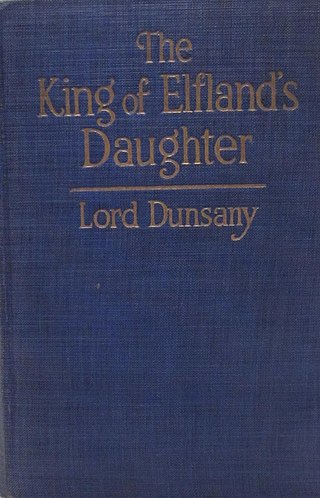
The King of Elfland's Daughter is a 1924 fantasy novel by Anglo-Irish writer Lord Dunsany. It is widely recognized as one of the most influential and acclaimed works in all of fantasy literature. Although the novel faded into relative obscurity following its initial release, it found new longevity and wider critical acclaim when a paperback edition was released in 1969 as the second volume of the Ballantine Adult Fantasy series.

The Survivor and Others is a collection of fantasy and horror short stories by American writer August Derleth. It was released in an edition of 2,096 copies. It was reissued in paperback by Ballantine Books in 1962 and 1971. The stories were based on and inspired by unused ideas of H. P. Lovecraft, and billed as "posthumous collaborations" with him. Derleth was in fact Lovecraft's literary executor after the latter's death in 1937.

The Broken Sword is a fantasy novel by American writer Poul Anderson, originally published on 5 November 1954. It was issued in a revised edition by Ballantine Books as the twenty-fourth volume of their Ballantine Adult Fantasy series in January 1971. The original text was returned to print by Gollancz in 2002. The novel is set during the Viking Age and the story contains many references to Norse mythology.

Great Short Novels of Adult Fantasy Volume II is an anthology of fantasy novellas, edited by American writer Lin Carter. It was first published in paperback by Ballantine Books in March, 1973 as the fifty-sixth volume of its Ballantine Adult Fantasy series. It was the ninth such anthology assembled by Carter for the series.

The Shaving of Shagpat: An Arabian Entertainment is a fantasy novel by English writer George Meredith. It was first published in hardcover by Chapman and Hall in 1856, and there have been numerous editions since. Its importance in the history of fantasy literature was recognized by its reissuing by Ballantine Books as the seventeenth volume of the Ballantine Adult Fantasy series in July 1970. The Ballantine edition includes an introduction by Lin Carter.
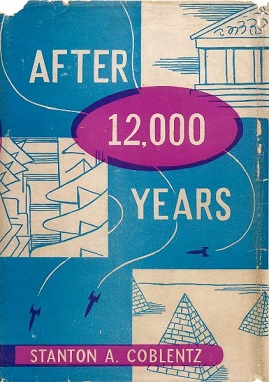
After 12,000 Years is a science fiction magazine serial and novel by American writer Stanton A. Coblentz. Considered one of the author's most bizarre and most interesting futuristic fantasies, the story originally appeared as a novella in the Spring 1929 issue of the magazine Amazing Stories Quarterly. It was later expanded and serialized for the pulp magazine Uncanny Tales in 1942, before being published in book form in 1950 by Fantasy Publishing Company, Inc. (FPCI). Lloyd Arthur Eshbach regarded this as one of the stronger titles published by FPCI. The story was abridged for the FPCI publication, in an edition of 1,000 copies, of which 750 were hardback. E. F. Bleiler considered the unabridged version to be superior.

Ombria in Shadow is a fantasy novel by American writer Patricia A. McKillip, first published by Ace Books in 2002. It won the 2003 World Fantasy Award and Mythopoeic Award. The book centres on the activities of several characters who inhabit a shadowy city beset by intrigue and entropy.
Evelyn E. Smith was an American writer of science fiction and mysteries, as well as a compiler of crossword puzzles.


















